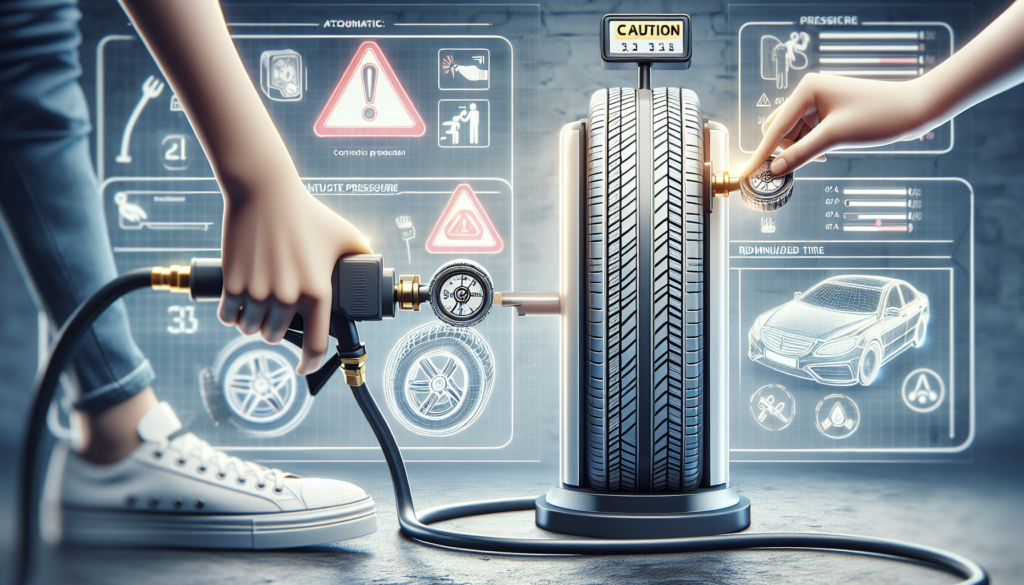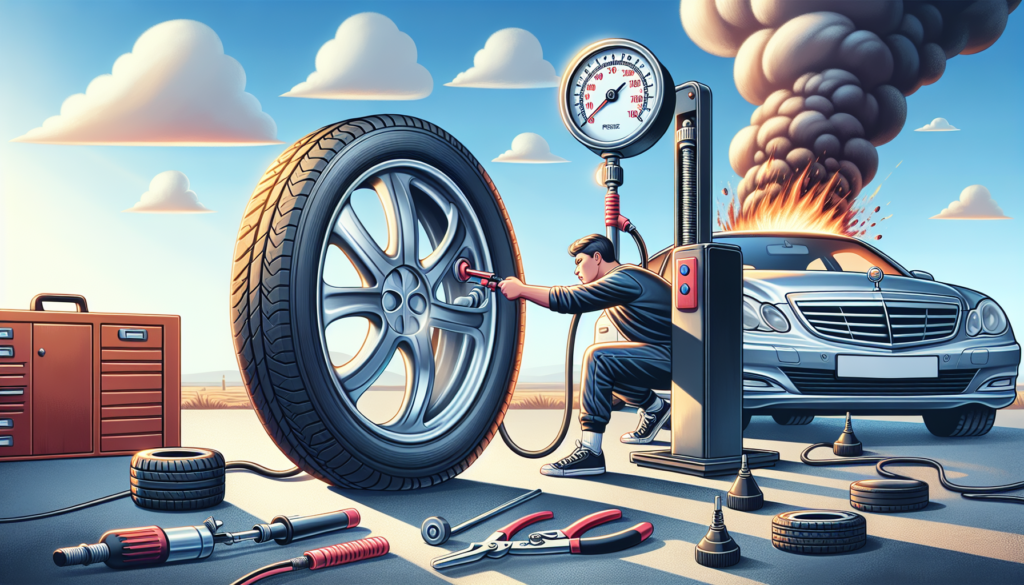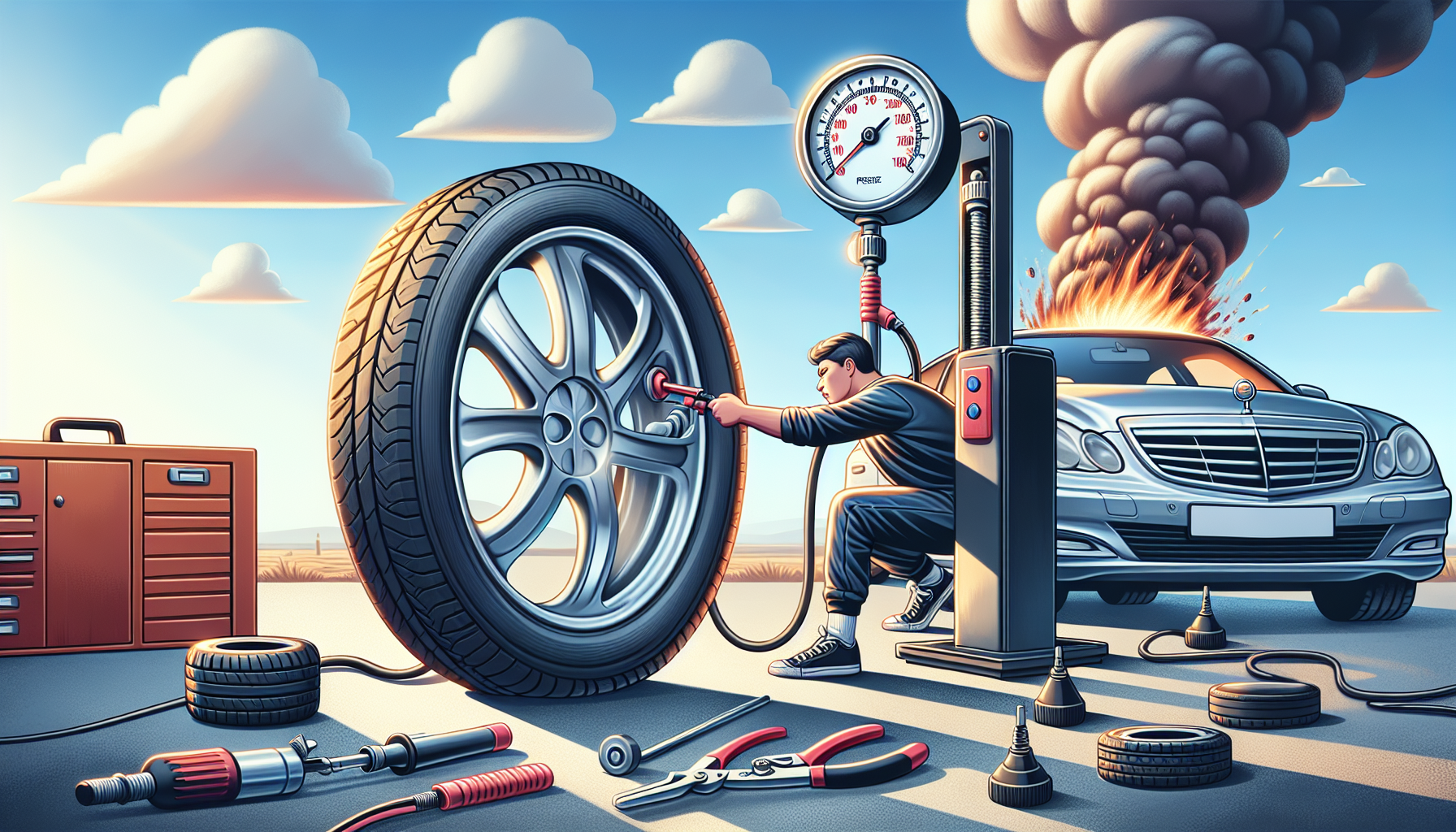You’re in luck! In this article, we’ll uncover the secrets to avoiding overinflating your tires with automatic pumps. We all know that keeping our tire pressure at the right level is essential for both safety and optimal performance. But sometimes, when using automatic pumps, it can be a bit tricky to strike that perfect balance. Don’t worry, though, because we’ve got you covered. With a few simple tips and tricks up your sleeve, you’ll soon be a pro at ensuring your tires are just right, neither underinflated nor overinflated. So, let’s jump right in and discover how you can avoid overinflating your tires with those handy automatic pumps!

Understanding automatic pumps
What are automatic pumps?
Automatic pumps are devices designed to inflate tires and maintain the correct tire pressure automatically. These pumps provide a convenient and efficient solution for motorists, eliminating the need to manually measure tire pressure and inflate them using traditional methods.
How do automatic pumps work?
Automatic pumps utilize a built-in pressure sensor that measures the current tire pressure. The user sets a target pressure, and the pump inflates the tire until the desired pressure is reached. Once the target pressure is achieved, the pump automatically shuts off, preventing overinflation.
Why are automatic pumps convenient?
Automatic pumps offer several advantages over manual inflation methods. Firstly, they save time and effort by eliminating the need for manual pressure checks and tire inflation. Additionally, automatic pumps ensure precise tire pressure, reducing the risk of overinflation or underinflation. Their portability and ease of use make them a valuable tool for both occasional users and professional mechanics.
Potential risks of overinflating tires
What happens when tires are overinflated?
Overinflation occurs when the tire pressure exceeds the recommended level. This excessive pressure causes the tire to become overly rigid, leading to a smaller contact patch with the road. As a result, the tire’s center wears down more quickly, while the edges remain relatively untouched. This uneven wear patterns can result in reduced traction and compromised handling.
How does overinflation affect vehicle performance?
Overinflated tires can negatively impact various aspects of vehicle performance. The excessive pressure causes a harsher ride, as the tires are less able to absorb bumps and road imperfections. Furthermore, overinflated tires are more prone to punctures and blowouts, as the increased internal pressure adds stress to the tire structure. Additionally, overinflation can negatively affect braking distance and overall vehicle stability.
Why is it important to avoid overinflating tires?
Overinflation not only compromises safety but also reduces the lifespan of tires. Tires that are constantly overinflated will experience accelerated tread wear, leading to the need for premature replacement. By maintaining the correct tire pressure, drivers can ensure optimal performance, handling, and longevity for their tires, ultimately saving money and ensuring their safety on the road.
Determining the correct tire pressure
Manufacturer’s recommended PSI
The first step to determining the correct tire pressure is to consult the vehicle’s manual or the tire placard located on the driver’s side door jamb or inside the fuel filler door. These sources provide the manufacturer’s recommended PSI (pounds per square inch) for both the front and rear tires. It’s important to note that these recommendations may vary depending on the specific vehicle model and tire size.
Factors affecting tire pressure
While the manufacturer’s recommendations are a good starting point, it’s important to consider certain factors that can affect tire pressure. Temperature fluctuations, load weight, and driving conditions can all impact tire pressure. For example, colder temperatures can cause tire pressure to decrease, while extended highway driving can increase tire temperature and subsequently raise the pressure.
Understanding the tire pressure rating
When determining the correct tire pressure, it’s crucial to understand the tire pressure rating specified by the tire manufacturer. This rating indicates the maximum recommended pressure that the tire can safely handle. It’s important not to exceed this rating to avoid tire damage or failure. The tire pressure rating can typically be found on the sidewall of the tire or in the tire manufacturer’s documentation.
Choosing the right automatic pump
Features to look for in an automatic pump
When selecting an automatic pump, it’s essential to consider certain features that enhance its functionality and convenience. Look for a pump with a digital pressure display, as this provides accurate readings and allows for precise pressure adjustments. An automatic shut-off feature is also crucial, as it prevents overinflation by stopping the pump once the target pressure is reached. Additionally, consider the pump’s power source (AC or DC), cord length, and portability features to suit your specific needs.
Digital vs. analog pressure gauges
Automatic pumps are available with both digital and analog pressure gauges. While analog gauges can still provide accurate readings, digital gauges offer greater precision and ease of use. Digital displays are typically backlit and provide clear and easy-to-read readings, making them ideal for dark or low-light conditions. Digital pressure gauges also tend to be more durable and resistant to damage.
Benefits of automatic shut-off feature
The automatic shut-off feature is a crucial aspect of an automatic pump. This feature ensures that the pump stops inflating the tire once the desired pressure is reached, preventing overinflation. By eliminating the need for manual monitoring or guesswork, the automatic shut-off feature saves time and reduces the risk of tire damage. It allows users to set the desired pressure, start the inflation process, and trust that the pump will handle the rest.

Using an automatic pump correctly
Preparation before inflating
Before using an automatic pump, it’s essential to ensure the tire is in good condition and free of any visible damage or punctures. Remove any valve stem caps and attach the pump’s hose securely to the tire valve stem. It’s important to ensure a tight seal to prevent any air leakage during inflation. Additionally, make sure the pump is properly connected to a power source, whether it be an electrical outlet or a vehicle’s DC power outlet.
Starting the automatic pump
Once the pump is connected and the hose is securely attached, start the pump according to the manufacturer’s instructions. Some pumps require pressing a power button, while others may activate automatically upon connection. Set the target pressure to the recommended PSI or the desired pressure level. The pump will begin inflating the tire until the target pressure is reached. The automatic shut-off feature ensures that the pump stops once the desired pressure is achieved.
Monitoring the tire pressure
While the automatic pump handles the inflation process, it’s still important to monitor the tire pressure. After the pump shuts off, use a separate tire pressure gauge to double-check the pressure and ensure it matches the desired level. If necessary, make any adjustments using the automatic pump or release air from the tire to reach the correct pressure. Regularly checking and maintaining the tire pressure helps prevent overinflation and ensures optimal tire performance.
Avoiding overinflation through regular checks
Importance of regular tire pressure checks
Regular tire pressure checks are essential for maintaining safe and efficient vehicle operation. It’s recommended to check tire pressure at least once a month using a reliable tire pressure gauge. By keeping the tires properly inflated, drivers can ensure optimal handling, braking, and fuel efficiency. Regular pressure checks also allow for early detection of any issues, such as slow leaks or sudden pressure loss.
Periodic maintenance schedule
In addition to monthly pressure checks, it’s important to follow a periodic maintenance schedule for comprehensive tire care. Rotate tires every 5,000 to 7,000 miles to ensure even wear and prolong tire life. Regularly inspect tires for signs of damage or unusual wear patterns and promptly address any issues. Adequate maintenance helps maintain optimal tire performance and reduces the risk of overinflation or other tire-related problems.
Signs of overinflation
While regular pressure checks are crucial, it’s also important to be aware of signs that may indicate overinflation. Overinflated tires may exhibit increased stiffness and a harsher ride quality. They may also show excessive wear in the center of the tire tread, while the outer edges appear relatively untouched. Reduced traction, reduced fuel efficiency, and an increased risk of tire blowouts are also indicators that the tires may be overinflated.

Tips for preventing overinflation
Avoid inflating tires when hot
To prevent overinflation, it’s important to avoid inflating tires when they are hot. Tires heat up during normal driving, which increases the internal pressure. If tire pressure is checked immediately after driving, it may show higher readings and lead to overinflating the tires. It’s recommended to wait at least one hour after driving or inflate the tires when they are cold for accurate pressure readings.
Set the target pressure correctly
Properly setting the target pressure on the automatic pump is crucial for avoiding overinflation. It’s essential to refer to the vehicle’s manual or the tire placard for the recommended PSI and set the pump accordingly. Do not inflate the tires above the recommended level. Overinflating to achieve a firmer ride or higher fuel efficiency is not advisable and can lead to decreased traction, uneven tire wear, and other safety hazards.
Using a tire pressure gauge alongside the automatic pump
While automatic pumps provide convenient and reliable inflation, it’s still recommended to use a separate tire pressure gauge to double-check the pressure after inflation. This serves as a backup measure to ensure the pump’s accuracy and the correct tire pressure. Tire pressure gauges are affordable and readily available, making them an invaluable tool to maintain optimal tire performance and safety.
Common mistakes and misconceptions
Relying solely on automatic pump readings
One common mistake is relying solely on the readings provided by the automatic pump. While automatic pumps are generally accurate, there can be slight variations in readings depending on the specific pump model. To ensure the correct tire pressure, it’s always advisable to use a separate tire pressure gauge to verify the readings and make any necessary adjustments.
Ignoring the recommended tire pressure
Ignoring the recommended tire pressure is another misconception that can lead to overinflation. The recommended PSI indicated by the vehicle manufacturer is based on extensive testing and ensures optimal performance, safety, and durability. Deviating from these recommendations can compromise vehicle handling, tire lifespan, and overall safety on the road.
Assuming all automatic pumps are accurate
While automatic pumps are designed to provide accurate readings and inflate tires accordingly, it’s essential to acknowledge that not all pumps may have the same level of accuracy. Different pumps can vary in terms of calibration and precision, which is why using a separate tire pressure gauge to verify the pressure is always recommended. Being aware of potential variations helps ensure reliable inflation and prevents overinflation.

Understanding the consequences of overinflation
Increased risk of tire blowouts
Overinflated tires are more susceptible to blowouts due to increased internal pressure and reduced flexibility. The excessive pressure strains the tire’s structure and can lead to failure, especially when exposed to additional stress or road hazards. Tire blowouts can result in sudden loss of control, causing accidents and potentially endangering both the driver and other road users. Maintaining the correct tire pressure is essential to minimize the risk of such incidents.
Uneven tire wear and reduced tread life
Overinflated tires experience accelerated wear in the center of the tread, leading to uneven tire wear patterns. The reduced contact patch with the road also affects traction, handling, and braking performance. Uneven tire wear can significantly reduce the tire’s overall lifespan, requiring premature replacement and additional expenses. By avoiding overinflation, drivers can ensure even tire wear, prolong tread life, and maximize the value of their tires.
Negative impact on fuel efficiency
Overinflated tires can negatively impact fuel efficiency due to increased rolling resistance. When the tire is overly rigid, it has less flexibility to absorb road irregularities, translating into a harsher ride and greater energy consumption. The increased resistance requires the engine to work harder, resulting in higher fuel consumption. Properly inflated tires, on the other hand, offer optimal rolling resistance, ensuring efficient fuel usage and cost savings over time.
Seeking professional assistance
When to consult a mechanic or tire expert
While automatic pumps and regular maintenance can address most tire-related concerns, there are instances when it’s necessary to seek professional assistance. Consulting a mechanic or tire expert is advisable in the following situations:
- Severely damaged or punctured tires: If a tire is severely damaged or punctured, it’s best to have it inspected and repaired or replaced by a professional.
- Persistent pressure loss: If a tire consistently loses pressure, there may be an underlying issue, such as a slow leak or a damaged valve stem. A professional can identify and resolve the problem.
- Unusual wear patterns: If tires exhibit unusual wear patterns that cannot be corrected through regular maintenance, a professional can assess the issue and suggest appropriate solutions.
- Suspension or alignment concerns: Alignment issues or problems with the suspension can cause uneven tire wear and affect tire performance. Professionals can diagnose and rectify these issues.
- Lack of experience or confidence: If unsure about using an automatic pump or performing tire maintenance, it’s best to seek professional guidance for accurate and safe tire care.
Importance of proper tire maintenance
Proper tire maintenance is crucial for optimal vehicle performance, safety, and longevity. Regular tire checks, pressure measurements, and visual inspections help ensure that tires are in good condition and operating at their best. By following proper maintenance practices, drivers can prevent overinflation, avoid tire-related issues, improve fuel efficiency, and enhance overall driving experience.
Benefits of regular professional inspections
Periodic professional inspections offer numerous benefits when it comes to tire health and overall vehicle safety. Trained technicians can provide comprehensive tire assessments, ensuring that tires are in proper condition, correctly inflated, and free from any hidden damage or potential issues. Professionals can also recommend suitable tire maintenance practices, address concerns like tire rotation or alignment, and provide valuable advice for maximizing tire performance and longevity.
In conclusion, understanding automatic pumps and how to avoid overinflating tires is essential for maintaining optimal vehicle performance, safety, and cost-effectiveness. By following the recommended tire pressure, utilizing the features of an automatic pump correctly, regularly checking tire pressure, and seeking professional assistance when needed, drivers can prevent overinflation and enjoy the benefits of properly inflated tires. Remember, proper tire maintenance not only enhances safety but also contributes to the overall driving experience and extends the life of your tires. So, equip yourself with the knowledge and tools necessary to keep your tires at the correct pressure, and hit the road with confidence.


